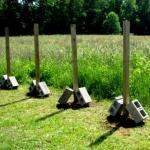1 slide
The work of students of grade 11 B of School No. 288 in Zaozersk Erina Maria and Staritsyna Svetlana

2 slide
Electricity is a physical term widely used in technology and in everyday life to determine the amount of electrical energy supplied by the generator to the electrical network or received from the network by the consumer. Electricity is also a commodity purchased by wholesale market participants from generating companies and electricity consumers in the retail market from energy sales companies.

3 slide
There are several ways to create electricity: Various power plants (HPP, NPP, TPP, PPP ...) As well as alternative sources (solar energy, wind energy, Earth energy)

4 slide
Thermal power plant (TPP), a power plant that generates electrical energy as a result of the conversion of thermal energy released during the combustion of fossil fuels. The first thermal power plants appeared at the end of the 19th century and became widespread. In the mid-70s of the 20th century, thermal power plants were the main type of power plants. At thermal power plants, the chemical energy of the fuel is converted first into mechanical and then into electrical energy. The fuel for such a power plant can be coal, peat, gas, oil shale, fuel oil.

5 slide
Hydroelectric power station (HPP), a complex of structures and equipment through which the energy of the flow of water is converted into electrical energy. The hydroelectric power station consists of a series of hydraulic structures that provide the necessary concentration of water flow and the creation of pressure, and power equipment that converts the energy of water moving under pressure into mechanical rotational energy, which, in turn, is converted into electrical energy.

6 slide
Nuclear power plant A power plant that converts nuclear energy into electrical energy. The power generator at a nuclear power plant is a nuclear reactor. The heat that is released in the reactor as a result of a chain reaction of fission of the nuclei of some heavy elements, then, just like in conventional thermal power plants, is converted into electricity. Unlike thermal power plants operating on fossil fuels, nuclear power plants operate on nuclear fuel.

7 slide
About 80% of GDP growth (gross domestic product) in developed countries is achieved through technical innovation, most of which is related to the use of electricity. Everything new in industry, agriculture and everyday life comes to us thanks to new developments in various branches of science. Modern society cannot be imagined without the electrification of production activities. Already at the end of the 1980s, more than 1/3 of all energy consumption in the world was carried out in the form of electrical energy. By the beginning of the next century, this proportion may increase to 1/2. Such an increase in electricity consumption is primarily associated with an increase in its consumption in industry.

8 slide
This raises the problem of efficient use of this energy. When electricity is transmitted over long distances, from the producer to the consumer, heat losses along the transmission line grow in proportion to the square of the current, i.e. if the current doubles, then the heat loss increases by a factor of 4. Therefore, it is desirable that the current in the lines be small. To do this, increase the voltage on the transmission line. Electricity is transmitted through lines where the voltage reaches hundreds of thousands of volts. Near cities that receive energy from transmission lines, this voltage is brought to several thousand volts using a step-down transformer. In the city itself, at substations, the voltage drops to 220 volts.

9 slide
Our country occupies a large territory, almost 12 time zones. And this means that if in some regions electricity consumption is maximum, then in others the working day has already ended and consumption is decreasing. For the rational use of electricity generated by power plants, they are combined into the power systems of individual regions: the European part, Siberia, the Urals, the Far East, etc. Such a combination allows you to use electricity more efficiently by coordinating the operation of individual power plants. Now various energy systems are united into a single energy system of Russia.
slide presentation
Slide text: Production, transmission and use of electrical energy. Developed by: N.V.Gruzintseva. Krasnoyarsk

Slide text: Project goal: Understanding the production, transmission and use of electrical energy. Project objectives to consider: Generation of electrical energy. Transformers. Production and use of electrical energy. Electricity transmission. Efficient use of electricity.

Slide text: Introduction: Electric current is generated in generators-devices that convert energy of one kind or another into electrical energy. Generators include: Galvanic cells. electrostatic batteries. Thermopile. Solar panels. and so on.

Slide text: If a body or several interacting bodies (a system of bodies) can do work, then they say that they have energy. Energy is a physical quantity that shows how much work a body (or several bodies) can do. Energy is expressed in the SI system in the same units as work, i.e. in joules.

Slide text: Electromechanical induction alternators predominate. Mechanical energy Electrical energy To obtain a large magnetic flux in generators, a special magnetic system is used, consisting of: Stator; Generator; Rings; Turbine; Frame; Rotor; brushes; Pathogen.

Slide text: AC conversion, in which the voltage increases or decreases several times with virtually no power loss, is carried out using transformers. Transformer device: Closed steel core assembled from plates; Two (sometimes more) coils with wire windings. primary, secondary, applied to the source, an alternating voltage is connected to it. load, i.e. appliances and devices that consume electricity.

Slide text: Energy source at thermal power plants: coal, gas, oil, fuel oil, oil shale, coal dust. Provide 40% electricity. Internal Energy wires TPP CONSUMER

Slide text: Potential energy of water is used to rotate the rotors of generators at a hydroelectric power station. Provide 20% electricity. HPP CONSUMER Internal energy of wires

Slide text: industry transport industrial and domestic needs mechanical energy ELECTRICITY
Slide #10

Slide text: Power stations in a number of regions of the country are connected by high-voltage power lines, forming a common electrical circuit to which consumers are connected. Such an association is called a power system. Electricity transmission. noticeable losses Consumer transformer voltage goes down; transformer voltage increases; current decreases.
slide 2
Electricity Electricity is a physical term widely used in technology and in everyday life to determine the amount of electrical energy supplied by the generator to the electrical network or received from the network by the consumer. The basic unit of measurement for the generation and consumption of electrical energy is the kilowatt-hour (and its multiples). For a more accurate description, parameters such as voltage, frequency and number of phases (for alternating current), rated and maximum electric current are used. Electricity is also a commodity purchased by wholesale market participants (energy sales companies and large wholesale consumers) from generating companies and consumers of electricity in the retail market from energy sales companies. The price of electricity is expressed in rubles and kopecks per kilowatt-hour consumed (kop/kWh, rub/kWh) or in rubles per thousand kilowatt-hours (rub/thousand kWh). The last price expression is usually used in the wholesale market. Dynamics of world electricity production by years
slide 3
Dynamics of world electricity production Year billion kWh 1890 - 9 1900 - 15 1914 - 37.5 1950 - 950 1960 - 2300 1970 - 5000 1980 - 8250 1990 - 11800 2000 - 14500 2002 - 16100.2 2003 - 16700.9 2004 - 17468.5 2005 - 18138.3
slide 4
Industrial power generation In the era of industrialization, the vast majority of electricity is generated industrially in power plants. Share of electricity generated in Russia (2000) Share of electricity generated in the world Thermal power plants (TPP) 67%, 582.4 billion kWh Hydroelectric power plants (HPP) 19%; 164.4 billion kWh Nuclear power plants (NPPs) 15%; 128.9 billion kWh Recently, due to environmental problems, the shortage of fossil fuels and its uneven geographical distribution, it has become expedient to generate electricity using wind turbines, solar panels, small gas generators. Some states, such as Germany, have adopted special programs to encourage investment in household electricity generation.
slide 5
Power transmission scheme
slide 6
Electrical network - a set of substations, switchgears and transmission lines connecting them, designed for the transmission and distribution of electrical energy. Classification of electrical networks It is customary to classify electrical networks according to their purpose (field of application), scale characteristics, and the type of current. Purpose, area of application Networks of general purpose: power supply of domestic, industrial, agricultural and transport consumers. Autonomous power supply networks: power supply of mobile and autonomous objects (vehicles, ships, aircraft, spacecraft, autonomous stations, robots, etc.) Networks of technological facilities: power supply of production facilities and other engineering networks. Contact network: a special network that serves to transmit electricity to vehicles moving along it (locomotive, tram, trolleybus, metro).
Slide 7
The history of the Russian, and perhaps, the world electric power industry, dates back to 1891, when the outstanding scientist Mikhail Osipovich Dolivo-Dobrovolsky carried out the practical transmission of electric power of about 220 kW over a distance of 175 km. The resulting transmission line efficiency of 77.4% was sensationally high for such a complex multi-element design. Such a high efficiency was achieved thanks to the use of a three-phase voltage, invented by the scientist himself. In pre-revolutionary Russia, the capacity of all power plants was only 1.1 million kW, and the annual electricity generation was 1.9 billion kWh. After the revolution, at the suggestion of V. I. Lenin, the famous GOELRO plan for the electrification of Russia was launched. It provided for the construction of 30 power plants with a total capacity of 1.5 million kW, which was completed by 1931, and by 1935 it was overfulfilled by 3 times.
Slide 8
In 1940, the total capacity of Soviet power plants amounted to 10.7 million kW, and the annual electricity generation exceeded 50 billion kWh, which was 25 times higher than the corresponding figures for 1913. After a break caused by the Great Patriotic War, the electrification of the USSR resumed, reaching a production level of 90 billion kWh in 1950. In the 50s of the XX century, such power plants as Tsimlyanskaya, Gyumushskaya, Verkhne-Svirskaya, Mingachevirskaya and others were put into operation. By the mid-1960s, the USSR ranked second in the world in terms of electricity generation after the United States. Main technological processes in the electric power industry
Slide 9
Electricity generation Electricity generation is the process of converting various types of energy into electrical energy at industrial facilities called power stations. Currently, there are the following types of generation: Thermal power industry. In this case, the thermal energy of combustion of organic fuels is converted into electrical energy. The thermal power industry includes thermal power plants (TPPs), which are of two main types: Condensing (CPP, the old abbreviation GRES is also used); Cogeneration (thermal power plants, thermal power plants). Cogeneration is the combined generation of electrical and thermal energy at the same station;
Slide 10
The transmission of electrical energy from power plants to consumers is carried out through electric networks. The electric grid economy is a natural monopoly sector of the electric power industry: the consumer can choose from whom to buy electricity (i.e. the power supply company), the power supply company can choose among wholesale suppliers (electricity producers) , however, the network through which electricity is supplied is usually one, and the consumer technically cannot choose the electric grid company. Power lines are metal conductors that carry electricity. At present, alternating current is used almost everywhere. The power supply in the vast majority of cases is three-phase, so the power line, as a rule, consists of three phases, each of which can include several wires. Structurally, power lines are divided into overhead and cable.
slide 11
Overhead power lines are suspended above the ground at a safe height on special structures called supports. As a rule, the wire on the overhead line has no surface insulation; insulation is available at the points of attachment to the supports. Overhead lines have lightning protection systems. The main advantage of overhead power lines is their relative cheapness compared to cable ones. Maintainability is also much better (especially in comparison with brushless cable lines): no excavation is required to replace the wire, visual inspection of the line condition is not difficult.
slide 12
Cable lines (CL) are carried out underground. Electric cables have different designs, but common elements can be identified. The core of the cable is three conductive cores (according to the number of phases). Cables have both outer and core insulation. Usually transformer oil in liquid form, or oiled paper, acts as an insulator. The conductive core of the cable is usually protected by steel armor. From the outside, the cable is covered with bitumen.
slide 13
Efficient use of electricity The need for the use of electricity is increasing every day, because we live in an age of widespread industrialization. Without electricity, neither industry, nor transport, nor scientific institutions, nor our modern life can function.
Slide 14
There are two ways to meet this demand: I. Construction of new powerful power plants: thermal, hydraulic and nuclear, but this requires time and high costs. They also require non-renewable natural resources to function. II. Development of new methods and devices.
slide 15
But despite all the above methods of generating electricity, it must be saved and protected, and we will have everything
View all slides
slide 1
Description of the slide:
slide 2
Description of the slide:
slide 3
Description of the slide:
slide 4
Description of the slide:
slide 5
Description of the slide:
slide 6
Description of the slide:
Slide 7
Description of the slide:
Slide 8
Description of the slide:
Slide 9
Description of the slide:
The use of electricity in the fields of science Science directly affects the development of energy and the scope of electricity. About 80% of GDP growth in developed countries is achieved through technical innovations, most of which are related to the use of electricity. Everything new in industry, agriculture and everyday life comes to us thanks to new developments in various branches of science. Most scientific developments start with theoretical calculations. But if in the nineteenth century these calculations were made using pen and paper, then in the age of scientific and technological revolution (scientific and technological revolution), all theoretical calculations, selection and analysis of scientific data, and even linguistic analysis of literary works are done using computers (electronic computers), which operate on electrical energy, the most convenient for its transmission to a distance and use. But if initially computers were used for scientific calculations, now computers have come to life from science. Electronization and automation of production are the most important consequences of the "second industrial" or "microelectronic" revolution in the economies of developed countries. Science in the field of communications and communications is developing very rapidly.
Slide 10
Description of the slide:
slide 11
Description of the slide:
slide 1
Physics lesson in grade 11b using the regional component. Author: S.V.Gavrilova - teacher of physics at the Moscow State Educational Institution, secondary school p. Vladimiro-Aleksandrovskoe 2012
Subject. Production, transmission and use of electrical energy
slide 2

Type of lesson: a lesson of learning new material using regional material. The purpose of the lesson: the study of the use of electricity, starting with the process of generating it. Lesson objectives: Educational: to concretize the idea of schoolchildren about the methods of transmitting electricity, about the mutual transitions of one type of energy to another. Developing: further development of students' practical research skills, bringing the cognitive activity of children to a creative level of knowledge, development of analytical skills (when finding out the location of various types of power plants in the Primorsky Territory). Educational: development and consolidation of the concept of "energy system" on local history material, education of a careful attitude to the consumption of electricity. Equipment for the lesson: physics textbook for grade 11 G.Ya. Myakishev, B.B. Bukhovtsev, V.M. Charugin. Classic course. M., "Enlightenment", 2009; slide presentation for the lesson; projector; screen.
slide 3

What device is called a transformer? What is the principle behind the operation of a transformer? What is the primary winding of a transformer? Secondary? Define the transformation ratio. How is the efficiency of a transformer determined?
Repetition
slide 4

How would our planet live, How would people live on it Without warmth, magnet, light And electric rays? A. Mitskevich
slide 6

Advanced development of the electric power industry; Increasing the capacity of power plants; Centralization of electricity production; Wide use of local fuel and energy resources; Gradual transition of industry, agriculture, transport to electricity.
GOELRO plan
Slide 7

Electrification of Vladivostok
In February 1912, the first public power plant was put into operation in Vladivostok, which was named VGES No. 1. The station became the ancestor of "big" energy in the Primorsky Territory. Its power was 1350 kW.
Slide 8

By June 20, 1912, the station provided energy to 1785 subscribers of Vladivostok, 1200 street lamps. Since the launch of the tram on October 27, 1912, the station has been working with overload.
Slide 9

The rapid growth of Vladivostok, as well as the implementation of GOELRO plans, forced the expansion of the power plant. In 1927-28, and then in 1930-1932. work was carried out on the dismantling of the old and installation of new equipment. First of all, a major overhaul of all boilers and steam turbines was carried out, which guaranteed the continuous operation of the station with energy output up to 2775 kW per hour. In 1933, the station completed its reconstruction and reached a capacity of 11,000 kW.
Slide 10

- Why was the development of the electric power industry put in the first place for the development of the state? What is the advantage of electricity over other types of energy? - How is electricity transmitted? – What is the energy system of our region?
slide 11

Transfer by wire to any locality; Easy transformation into any kind of energy; Easy to get from other types of energy.
The advantage of electricity over other types of energy.
slide 12

Types of energy converted into electrical
slide 13

Wind (WPP) Thermal (TPP) Water (HPP) Nuclear (NPP) Geothermal Solar
Depending on the type of converted energy, power plants are:
Where is electricity produced?
Slide 14

slide 15

Vladivostok CHPP-1
Since 1959, the station began to work on a heat load, for which a number of measures were taken to transfer it to a heating mode. In 1975, the generation of electricity at VTETS-1 was discontinued, and the CHPP began to specialize exclusively in heat generation. Today it is still in service, successfully operating, supplying Vladivostok with heat. In 2008, two mobile gas turbine units with a total capacity of 45 MW were installed at the VCHPP-1 site.
On the construction of the station
slide 16

Vladivostok CHPP-2
- the youngest station in the Primorsky Territory and the most powerful in the structure of the Primorsky generation.
A huge thermal power plant-2 was built in a short time. On April 22, 1970, the first units of the station were launched and turned on: a turbine and two boilers.
Currently, 14 boilers of the same type with a steam capacity of 210 tons/hour of steam each and 6 turbine units are operated at Vladivostok CHPP-2. Vladivostok CHPP-2 is the main source for supplying production steam, heat and electricity to industry and the population of Vladivostok. The main type of fuel for thermal power plants is coal.
Slide 17

Partizanskaya GRES
The Partizanskaya State District Power Plant (GRES) is the main source of electricity supply for the southeastern part of Primorsky Krai. The construction of a power plant in the immediate vicinity of the Suchansky coal region was planned as early as 1939-1940, but with the outbreak of World War II, work on the project was stopped.
From 01.02.2010 a turbine was put into operation at Partizanskaya GRES
Slide 18

Artemovskaya CHPP
On November 6, 1936, a test run of the first turbine of the new station was made. This day is considered to be the birthday of the Artyomovskaya State District Power Plant. Already on December 18 of the same year, Artemovskaya GRES entered the operation of existing enterprises in Primorye. November 6, 2012 Artyomovskaya CHPP celebrated its 76th anniversary.
In 1984, the station was transferred to the category of combined heat and power plants.
Slide 19

Primorskaya GRES
On January 15, 1974, the 1st power unit of the largest thermal power plant in the Far East, Primorskaya GRES, was launched. Putting it into operation became a major milestone in the socio-economic development of the region, which in the 1960s and 1970s experienced a severe shortage of electricity.
The launch of the 1st power unit, the subsequent construction and commissioning of the remaining eight power units of Primorskaya GRES helped the Unified Energy System of the Far East to radically solve the problem of meeting the growing demand for electricity in the region. Today, the station generates half of the electricity consumed in the Primorsky Territory, and produces thermal energy for the village of Luchegorsk.
Slide 20

Electricity transmission.
slide 21

The main consumers of electricity
Industry (almost 70%) Transport Agriculture Domestic needs of the population
slide 22

Transformer
a device that allows you to convert alternating electric current in such a way that when the voltage increases, the current will decrease and vice versa.
slide 23

slide 24

The UES of the Far East includes the power systems of the following regions: Amur Region; Khabarovsk Territory and Jewish Autonomous Region; Primorsky Territory; South Yakutsk energy district of the Republic of Sakha (Yakutia). The IPS of the East operates in isolation from the UES of Russia.
Slide 25

Electricity generation in the regions of the Far East in 1980-1998 (billion kWh)
Region 1980 1985 1990 1991 1992 1993 1994 1995 1996 1997 1998
Far East 30,000 38,100 47,349 48,090 44.2 41.4 38,658 36,600 35,907
Primorsky Krai 11.785 11.848 11.0 10.2 9.154 8.730 7.682
Khabarovsk Territory 9.678 10.125 9.7 9.4 7.974 7.566 7.642
Amur Region 4.415 7.059 7.783 7.528 7.0 7.0 7.074 6.798 6.100 5.600 5.200
Kamchatka region 1.223 1.526 1.864 1.954 1.9 1.8 1.576 1.600 1.504
Magadan Region 3.537 3.943 4.351 4.376 3.4 3.0 2.72 2.744 2.697
Sakhalin Region 2.595 3.009 3.41 3.505 2.8 2.7 2.712 2.390 2.410
Republic of Sakha 4.311 5.463 8.478 8.754 8.4 7.3 6.998 6.887 7.438
Chukotka Autonomous Okrug - - - - n.a. n.a. 0.450 0.447 0.434 0.341 0.350
slide 26

Power system of the Far East
In the Far East, generating capacities and transmission networks are combined into six power systems. The largest of them cover Primorsky Krai (installed capacity 2692 thousand kW) and the Republic of Sakha (2036 thousand kW). The remaining power systems have a capacity of less than 2 million kW. In order to ensure sustainable and cost-effective energy supply to hard-to-reach areas in the Primorsky Territory, it is planned to continue the construction of small hydropower plants.
Slide 27

Test Yourself (Test Work)
Option 1 I. What is the source of energy at TPP? 1. Oil, coal, gas 2. Wind power 3. Water power II. Which area of the economy consumes the largest amount of electricity produced? 1. In industry 2. In transport 3. In agriculture III. How will the amount of heat released by the wires change if the cross-sectional area of \u200b\u200bthe wire S is increased? 1. Will not change 2. Will decrease 3. Will increase 1. Step-down 2. Step-up 3. No transformer is needed V. The power system is 1. The electrical system of a power plant 2. The electrical system of a separate city 3. The electrical system of the regions of the country, connected by high-voltage power lines
Option 2 I. What is the source of energy for hydroelectric power plants? 1. Oil, coal, gas 2. Wind power 3. Water power II. The transformer is designed 1. To increase the service life of the wires 2. To convert energy 3. To reduce the amount of heat released by the wires III. The energy system is 1. The electrical system of a power plant 2. The electrical system of an individual city 3. The electrical system of the regions of the country, connected by high-voltage power lines IV. How will the amount of heat released by the wires change if the length of the wire is reduced? 1. Will not change 2. Will decrease 3. Will increase V. What transformer should be put on the line at the city entrance? 1. Step-down 2. Step-up 3. No transformer needed
Slide 28

How would our planet live, How would people live on it Without warmth, magnet, light And electric rays?
A. Mitskevich
Slide 29

Thanks for the lesson!
D.Z. § 39-41 "The use of solar energy for heat supply in the Primorsky Territory". "On the feasibility of using wind energy in the Primorsky Territory". "New Technologies in the World Energy of the 21st Century"


















